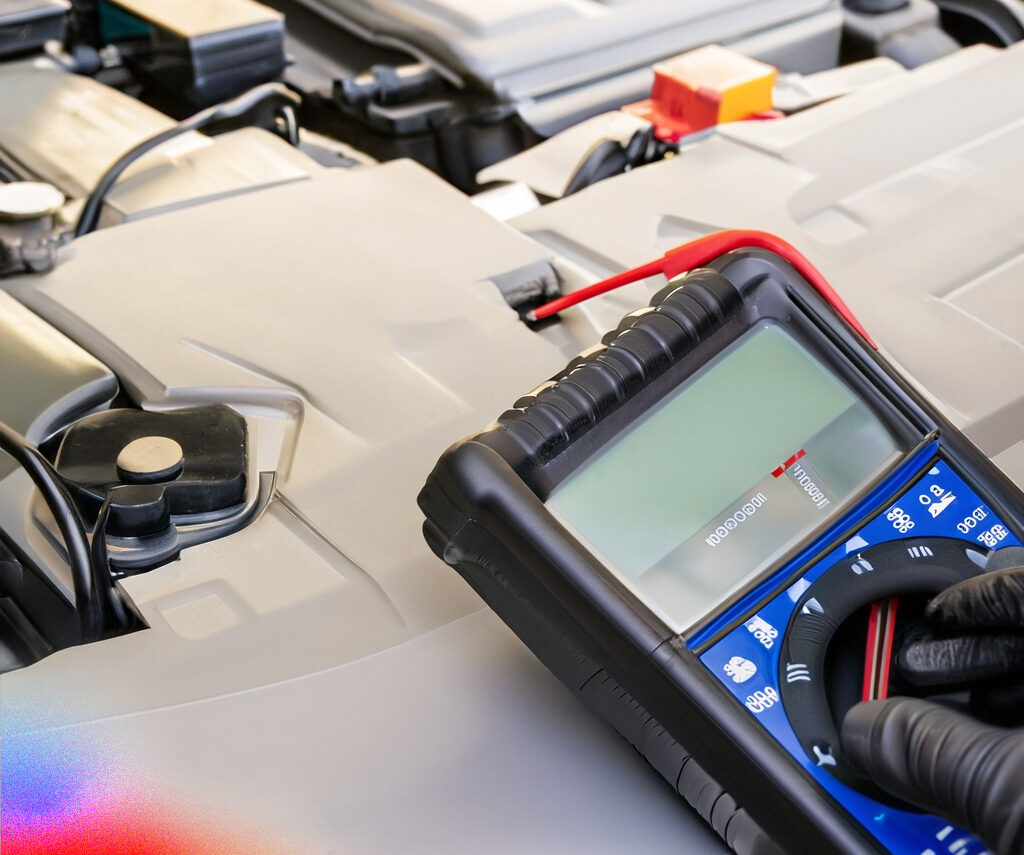Navigating the world of golf carts can be an exhilarating ride, especially when you own one. However, before the thrill comes the nitty-gritty of maintenance; and the lifeblood of your golf cart – the battery, demands significant attention. In this post, we’re going to voyage through the art of testing a golf cart battery using practical methods, guided by data and advice from Golf Cart Resource and Northeast Battery Blog. Whether you’re giving a voltmeter or hydrometer a shot, we have researched key insights and safety tips to bring you a comprehensive guide on how to keep track of your golf cart battery’s health. Hop in, as we fine-tune your skills to keep your golf cart running at optimal performance.
Importance of testing golf cart batteries
A well-performing battery is crucial for the optimal functioning of your golf cart. Without a healthy battery, the cart might struggle to generate the needed power, or worse, leave you stranded in the middle of the course. Hence, ensuring that your golf cart battery is in good health becomes essential.
Benefits of regular battery testing
Testing your golf cart battery regularly presents you with several advantages:
1. Avoid Unforeseen Issues: Regular battery testing can help identify potential problems before they escalate, ensuring the smooth operation of your golf cart.
2. Prolong Battery Life: By keeping tabs on the health of your battery, you can maximize its lifespan and get the most out of your investment.
3. Maintain Optimal Performance: A properly functioning battery is crucial for a smooth and enjoyable golfing experience. By regularly testing the battery, you can ensure your cart is always performing at its best.
Signs of a failing golf cart battery
Certain signs can indicate a potentially failing golf cart battery. Keep a lookout for:
• Slow Start: If the cart is slow to start or shows reduced speed, it can be an indication of a battery problem.
• Dwindling Charge: If the battery doesn’t seem to hold a charge as it used to or requires frequent recharging, it may be failing.
• Physical Damage: Any visible signs of battery damage, such as bulging, leakage, or corrosion, are alarm signals that you need to address.
For more in-depth knowledge about Electric golf-cart batteries, feel free to check out this Wikipedia article.
Preparing for the battery test
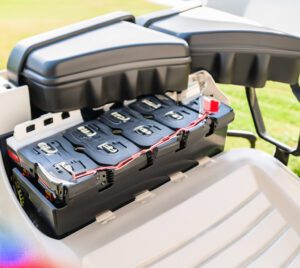
Before you delve into testing your golf cart battery, you need to prepare adequately by collecting the necessary tools and equipment and putting necessary safety measures in place.
Gathering necessary tools and equipment
Here are the essential tools and equipment needed for a golf cart battery test:
•A voltmeter: You need a voltmeter to measure the voltage of your battery. An ideal voltmeter for a golf cart battery test is a digital voltmeter due to its accuracy.
•Battery cleaner: This is used to clean up any corrosion on the battery.
•Protective gear: These include gloves and safety glasses for your own personal protection during the testing process.
Safety precautions to take
Safety should always come first when dealing with golf cart batteries. Below are some safety precautions to observe:
- Ensure you are wearing the right protective gear: This includes gloves and safety glasses. It’s also advisable to wear old clothes as battery acid can ruin your clothing.
- Work in a well-ventilated area: Stagnant air can lead to hydrogen build-up which is a potential fire risk. Therefore, ensure you work in an open, well-ventilated space or work outside.
- Don’t smoke near batteries: Batteries can emit hydrogen which can ignite. Therefore, avoid any open flames near your workspace.
By gathering the necessary tools and ensuring you’re in the right environment for the test, you’re all set to accurately assess the health of your golf cart battery.
Conducting a voltage test
The integrity of your golf cart battery’s output is crucial in determining its overall performance. Here, we detail the steps on how to conduct a voltage test for your battery.
RELATED: How to Add Torque To Golf Cart-
Step-by-step guide for voltage testing
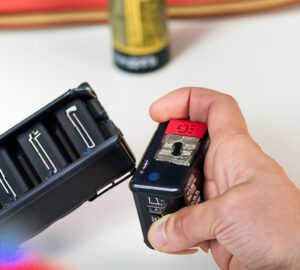
1. Preparation: Ensure that the golf cart is turned off. Wear necessary safety gear, like gloves and eyewear, before starting the procedure.
2. Access the Battery: Open the golf cart’s battery chamber to gain access to the terminals.
3. Connect the Multimeter: Connect the two probes of the multimeter to the battery terminals. The black probe should connect to the negative terminal while the red one goes to the positive terminal.
4. Read the Voltage: After the connection, turn the multimeter on. Set it to read voltage, typically a ‘V’ setting on the device. It will then display the battery’s voltage.
Interpreting the voltage readings
Once the reading is the display, you should be able to interpret the health status of your battery through the voltage output.
A healthy 6-volt battery should ideally show a reading from 5.9 to 6.3 volts. A 12-volt battery, on the contrary, should display anywhere between 11 and 13 volts. If the readings are significantly lower than these ranges, it may be a sign that your golf cart battery is approaching the end of its life cycle or may need immediate maintenance.
For more comprehensive information on battery maintenance and troubleshooting, you can check the golf cart battery guide on Wikipedia.
Performing a load test
A load test is a good way to assess the overall health and remaining lifespan of your golf cart battery. It can also help to identify potential issues before they become critical. It’s important to perform a load test when the battery is fully charged.
Steps involved in load testing
1. Charge and Prepare: Fully charge your golf cart battery prior to the test. Once the battery is fully charged, disconnect it from the golf cart.
2. Connect Load Tester: Connect a load tester across the battery terminals. If you don’t already have one, these can be relatively affordable and are definitely beneficial for regular golf cart maintenance.
3. Load Test: Apply a load that is equivalent to half of the CCA (Cold Cranking Amps) rating of the battery. Most load testers have a switch which allows you to do this.
4. Monitor: Hold the load for around 15 seconds and carefully monitor the voltage reading.
Analyzing the load test results:
After performing the load test, interpret the results as follows:
• If the voltage drops below 9.6 volts, the battery may be weak or faulty.
• If the voltage remains above 9.6 volts, the battery is in good condition.
For more details on battery testing, please refer to this Wikipedia article on battery testing. It’s crucial to regularly test your golf cart battery to ensure its efficient functioning, which will save you from potential hassles later on.
V. Using a hydrometer for testing
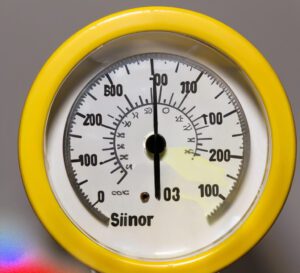
One of the best ways to test your golf cart battery is using a hydrometer. A hydrometer is a simple tool that measures the specific gravity of the electrolyte solution inside each battery cell. It works on the principle that a discharged battery has a higher concentration of sulfuric acid than a charged one.
Exploring the hydrometer testing method
Testing a golf cart battery with a hydrometer involves several steps. To start with, you need to calmly and safely remove the battery cap to access each cell–you should always wear protective gear for safety.
Here’s a step-by-step guide:
- Extract a sample of the electrolyte solution using the hydrometer.
- Take note of the specific gravity reading on the hydrometer scale.
- Repeat these steps for each cell in the battery.
Remember to keep the hydrometer clean between each cell to avoid contamination and inaccurate readings.
RELATED: How Do You Troubleshoot A Golf Cart Battery?
Understanding specific gravity readings
Interpreting the readings you get on the hydrometer is crucial in understanding the health of your golf cart battery. A fully charged golf cart battery should have a specific gravity of about 1.265 (at 80°F). Conversely, a completely discharged battery will typically have a specific gravity of 1.120.
Note that for each 10°F variance from the baseline temperature of 80°F, the specific gravity reading will adjust by 0.004. For example, if the temperature is 70°F, the fully charged specific gravity reading would be 1.261 (1.265-0.004).
Remember, consistency in readings across all cells is key. Large variations can indicate a defective or weak cell.
Performing a visual inspection
Before embarking on a technical review, it can be valuable to perform a simple visual inspection of the golf cart battery. The state of the battery can be a good indicator of its overall health.
Inspecting battery terminals and connections
It is smart to begin by inspecting the battery terminals and the connections. Look for rust, corrosion or other noticeable signs of wear and tear. Poor connections can result in reduced performance and could potentially lead to more serious issues if not addressed.
- Terminals: Examine the battery’s terminals carefully. Signs of corrosion (a bluish-white, powdery substance) can indicate a problem.
- Cables: Make sure the cables are secured tightly to the terminals. Loose connections can lead to power loss.
- Wiring: Check the wiring for any visible signs of damage, such as fraying or melting.
Identifying signs of battery damage or deterioration
Next, carefully review the battery itself for any signs of damage or deterioration.
- Case: Check the battery case for any noticeable cracks or leaks. This could be an indicator of a serious problem and could lead to a complete failure.
- Fluid Levels: The fluid level in each battery cell should be reviewed. Low fluid levels can damage the battery and affect performance. Refer to your electric vehicle battery manufacturer’s instructions on how to properly check and refill the fluid levels.
- Age: Lastly, consider the age of your battery. Most golf cart batteries are designed to last between 4-6 years. If your battery is approaching or beyond this range, it may be time for a replacement.
Through careful visual inspection, you can identify potential issues and take necessary steps toward maintaining your golf cart battery’s health.
Testing battery capacity
Every golf cart owner needs to be aware of the state of their batteries. Golf cart batteries are not cheap, and an underperforming battery can wreak havoc on your round of golf. But how to determine the remaining capacity of your golf cart battery? Here’s a quick overview.
Methods for determining the remaining battery capacity
Use a multimeter: A multimeter is a straightforward and cheap way to determine if your batteries are working correctly or declining. To use a multimeter:
- Test each battery cell individually.
- If the reading is 2.1 volts per cell (each cell is 2.1 volts, six cells mean 12.6 volts), then the battery is in good condition.
- If the reading is lower than 2.1 per cell, then the battery is not in good health.
Specific gravity test: This method measures the density of the battery acid in relation to pure water. For this test, you’ll need a hydrometer (gravity tester). The typical full-charge specific gravity is about 1.265.
- If the gravity varies more than .025 in any cell, you need to equalize the battery.
Interpreting the capacity test results
After testing, you need to interpret the results:
- If your battery passes both tests, then it’s performing well.
- If your battery shows poor results in both tests, it’s time to consider a replacement.
- If your battery tests good with one method and poor with another, you might want to conduct another test or consult with a battery expert to get a second opinion.
Remember, a good battery leads to a good day on the golf course. So regularly check your golf cart battery’s capacity and ensure it’s at its optimal performance.
Maintenance and care tips
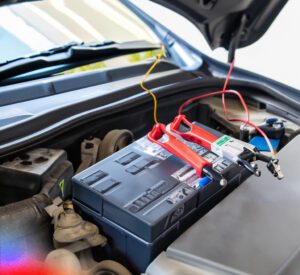
When it comes to golf cart battery maintenance and prolonging its life, a little goes a long way. Here are some key tips:
Best practices for prolonging battery life
1. Regular Charging: Always recharge your golf cart battery after every use, regardless of how far you’ve traveled. Frequent recharging helps condition the battery’s life cycle and prevents ‘deep discharging’ which can damage the battery over time.
2. Water Maintenance: Check and refill the water levels of your battery regularly. Use only distilled water to refill the battery, as regular tap water contains minerals that can damage the battery cells.
3. Proper Storage: If you aren’t using your golf cart for an extended period of time, store it properly. The battery should be fully charged, clean, and stored in a dry, cool place.
RELATED: Are Electric Golf Carts More Cost-Effective Than Gas-Powered Ones
Common mistakes to avoid
Just as there are best practices, there are also common mistakes to avoid to prolong your golf cart battery’s life:
1. Avoid Overcharging: While regular charging is essential, overcharging can lead to battery damage. A good battery charger should automatically switch off once the battery is fully charged.
2. Avoid draining the battery: Never allow your golf cart battery to completely discharge. It can decrease the battery’s lifespan and lead to irreversible damage.
3. Avoid using your golf cart battery until it’s fully charged: If you start using your golf cart when the battery is half-charged or less, it can strain and overheat the battery.
By keeping these best practices and mistakes in mind, you can ensure that your golf cart battery stays healthy and lasts longer. This minimizes the need for frequent battery replacements and reduces overall maintenance costs. Stay out on the green longer by taking proper care of your golf cart battery.
Troubleshooting common battery issues
Well-maintained golf cart batteries can typically last between four to ten years. However, even the best-cared-for batteries can sometimes encounter issues. If your golf cart battery appears to be malfunctioning, here are a few common problems to keep in mind:
- Battery discharges too quickly: If the battery seems to discharge faster than usual, check for possible leakage or damages to the battery case. This could cause acid to leak, thus resulting in rapid discharging.
- Golf cart doesn’t start: If your golf cart refuses to start, it’s likely that the battery is completely depleted or damaged.
- Golf cart runs inconsistently: If the cart’s performance is erratic – sometimes running smoothly and other times barely moving – the battery might be failing or the connections may be loose or corroded
Addressing common problems with golf cart batteries
If you’ve identified one of these common problems above, it is not necessarily the end for your battery. You can potentially troubleshoot the issue at home with the following solutions:
- Recharge the battery: If the battery is discharging quickly or the golf cart isn’t starting, try recharging it. This often solves the problem if the battery isn’t extremely old or damaged.
- Check the connections: Loose or corroded connections can lead to inconsistent performance. So make sure to check all battery connections and clean them if necessary.
- Test the battery voltage: Using a multimeter, check the voltage of your battery to find out if it’s within the right range.
Remember that if the problem persists, it’s best to consult with a professional or consider replacing the battery if it’s old or significantly damaged.
Troubleshooting tips and solutions
Always keep your protective gear on while handling batteries. For more detailed information about maintaining and troubleshooting your golf cart battery, visit this guide on Wikipedia.
Replacing or reconditioning batteries
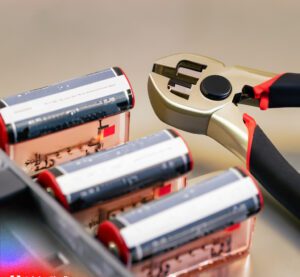
For anyone who owns and operates a golf cart, understanding when to replace or recondition its battery is crucial. If the vehicle is not starting as reliably as it used to or feels underpowered, it’s probably time to check the condition of its batteries.
Knowing when to replace a golf cart battery
To ensure your golf cart operates optimally, you must know when it’s time to replace its battery. Here are a few signs to look out for:
• Inadequate Power: If your golf cart is not achieving the same speed as before or struggling on inclines, it might be due to a weak battery.
• Decreased Range: If your battery isn’t lasting as long as it used to per single complete charge, this is an indication that its capacity to hold a charge is diminishing.
• Age: Lastly, consider the age of your golf cart battery. Typically, depending upon usage and maintenance, a golf cart battery can last anywhere between 4-6 years. If your battery falls within this range, it may be prudent to replace it, especially if you’re noticing a decline in performance.
If you are experiencing any of these issues, consider either reconditioning your battery or replacing it completely. However, always ensure your charger is working correctly before diagnosing a battery issue. Remember, a well-maintained golf cart battery can significantly enhance the performance and longevity of your cart!
Conclusion
As this guide comes to a close, the importance of regular maintenance and testing on your golf cart battery cannot be more strongly emphasized. A well-functioning battery not only ensures optimal performance of your golf cart but also significantly extends its lifespan.
Summary of the battery testing process
Let’s quickly recap the key steps of testing your golf cart battery:
1. Preparation: Make sure the golf cart is turned off, and you have your safety equipment (gloves, goggles) on. It’s essenital to have a multimeter and hydrometer at hand.
2. Visual Inspection: Look at the overall condition of the battery. Check for any visible signs of damage, corrosion or leakage.
3. Voltage Test: Using a multimeter, measure the voltage across the battery terminals.
4. Specific Gravity Test: Using a hydrometer, test the specific gravity of each cell in the battery.
Should either the voltage or specific gravity tests yield results outside the normal range, it might be time to consider replacing your golf cart battery.
Remember, consistent monitoring and maintenance are key to prolonging the life of your battery. If you face any uncertainties or difficulties, do not hesitate to seek help from a professional. A bit of focused attention today can save you a significant amount of time, money, and inconvenience in the long run!
Happy golfing!
FAQ’s
Why should I test my golf cart battery?
Regularly testing your golf cart battery is essential to ensure its performance and longevity. By testing, you can identify potential issues early on, such as low voltage or a failing cell, allowing you to take preventive measures or replace the battery if necessary.
How often should I test my golf cart battery?
It’s recommended to test your golf cart battery at least once a month. Regular testing helps you monitor its health and detect any changes in performance over time.
What tools do I need to test my golf cart battery?
To test your golf cart battery, you’ll need a digital voltmeter or a multimeter. These tools can measure the voltage of your battery and give you an idea of its state of charge.
How do I use a voltmeter to test my golf cart battery?
To use a voltmeter, set it to the DC voltage range and connect the red (positive) probe to the positive terminal of the battery and the black (negative) probe to the negative terminal. The voltmeter will display the battery’s voltage, allowing you to determine its current charge level.
What is a healthy voltage range for a golf cart battery?
A fully charged golf cart battery typically reads around 12.6 to 12.8 volts. However, the specific voltage range may vary depending on the battery type (lead-acid, lithium-ion, etc.) and the manufacturer’s recommendations. Generally, a voltage reading below 12.0 volts indicates a low charge and may require recharging.

I’m Donna Weiss, and I am the proud writer behind the captivating content you’ll find on golfneedy.com. As an avid golfer and passionate writer, I have combined my two greatest passions to bring you an incredible golfing experience. Through my articles, I aim to provide you with valuable insights, equipment reviews, and updates on the latest tournaments. Whether you’re a seasoned golfer or just starting out on this exciting journey, I am here to guide you and share my expertise. Together, let’s explore the fascinating world of golf, uncovering new techniques, and enhancing our skills. Join me on this thrilling adventure as we elevate our game and embark on an exciting golfing journey. Read More

